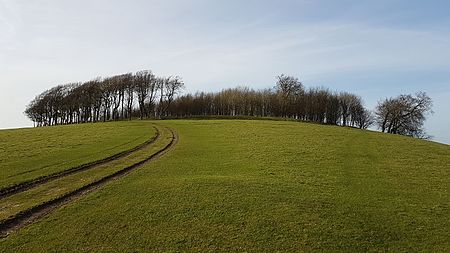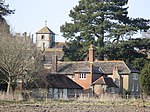Chanctonbury Ring

Chanctonbury Ring is a prehistoric hill fort atop Chanctonbury Hill on the South Downs, on the border of the civil parishes of Washington and Wiston in the English county of West Sussex. A ridgeway, now part of the South Downs Way, runs along the hill. It forms part of an ensemble of associated historical features created over a span of more than 2,000 years, including round barrows dating from the Bronze Age to the Saxon periods and dykes dating from the Iron Age and Roman periods. Consisting of a roughly circular low earthen rampart surrounded by a ditch, Chanctonbury Ring is thought to date to the late Bronze Age or early Iron Age. The purpose of the structure is unknown but it could have filled a variety of roles, including a defensive position, a cattle enclosure or even a religious shrine. After a few centuries of usage, it was abandoned for about five hundred years until it was reoccupied during the Roman period. Two Romano-British temples were built in the hill fort's interior, one of which may have been dedicated to a boar cult. After its final abandonment around the late fourth century AD, the hill fort remained unoccupied save for grazing cattle until a mid-18th-century landowner planted a ring of beech trees around its perimeter to beautify the site. They became a famous local landmark until largely being destroyed in the Great Storm of 1987. Periodic replanting on a number of occasions to replace old or destroyed trees has afforded archaeologists the opportunity to carry out a series of excavations which have revealed much about the history of the site.
Excerpt from the Wikipedia article Chanctonbury Ring (License: CC BY-SA 3.0, Authors, Images).Chanctonbury Ring
Wiston Bostal,
Geographical coordinates (GPS) Address External links Nearby Places Show on map
Geographical coordinates (GPS)
| Latitude | Longitude |
|---|---|
| N 50.89626 ° | E -0.38177 ° |
Address
Wiston Bostal
BN44 3DP
England, United Kingdom
Open on Google Maps










